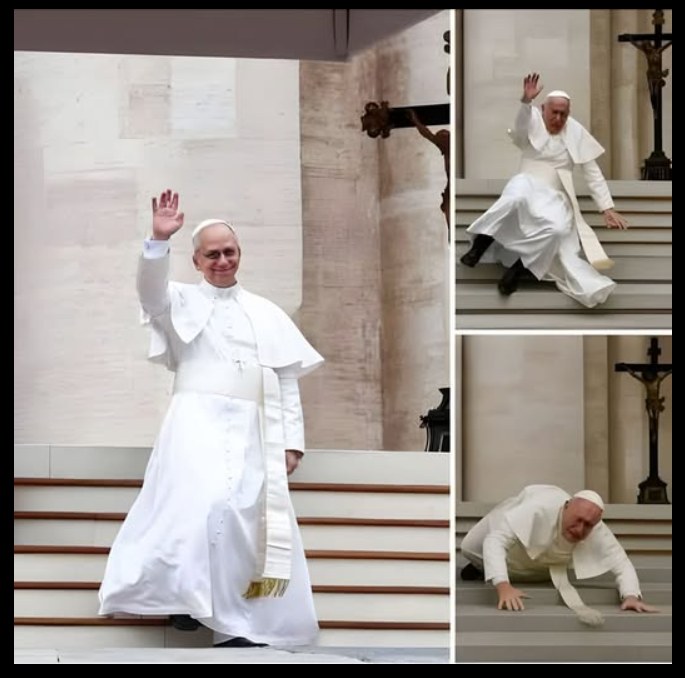
A photo recently went viral claiming to show “Leon XIV” experiencing a mishap where a gadget falls off him during a public appearance. While the image sparked widespread reactions and humorous commentary, it’s important to note that there is no official or credible source confirming the context of the image. This situation serves as a reminder of how easily misinformation can spread online. In the age of manipulated content and viral rumors, we should always approach media and social media claims with caution. Without reliable sources or verifiable evidence, what may seem like news could simply be a hoax, misunderstanding, or digitally altered image. Critical thinking and fact-checking are essential tools for navigating today’s information landscape.
The morning sun bathed St. Peter’s Square in golden light as the new pontiff, Pope Leo XIV, stood before a sea of white-clad cardinals, kneeling to receive the Palio —a crimson-red stole symbolizing his role as a servant of charity—and the Fisherman’s Ring, an ancient emblem of his spiritual authority. The crowd, a mosaic of pilgrims from every corner of the globe, erupted in applause as the ring was placed on his finger, its gold surface etched with the image of St. Peter casting his net. “Viva il Papa! ” they cried, their voices echoing off the basilica’s marble façade. Yet for the new pope, the ceremony was not just a coronation but a homecoming—a return to a journey that had begun decades earlier, not in the Vatican, but in the sunbaked streets of Chiclayo, Peru.
Born Jonathan Michael O’Shea in Chicago in 1967, Leo XIV’s path to the papacy was anything but conventional. The son of a Irish-American firefighter and a Peruvian immigrant mother, his childhood was a blend of Chicago winters and stories of Andean summers, told through his mother’s soft Spanish lilt. By the age of ten, he could recite the Rosary in both English and Spanish, a linguistic duality that mirrored his cultural identity. After studying theology at Notre Dame, he shocked his peers by joining a missionary order and departing for Peru in 12 days after graduation. “I needed to find God in the dust,” he later recalled, “not just in books.”
For nearly three decades, O’Shea served in Chiclayo, a city where poverty clung to the adobe walls of slums, and faith thrived in the simplest gestures: a shared meal, a whispered confession, a child’s laughter echoing through a chapel. He became known as “el Padre de las Calles” (the “Father of the Streets”) for his habit of walking through neighborhoods at dawn, blessing homes and chatting with vendors setting up their stalls. In 2003, he founded the Casa de la Esperanza , a shelter for street children that grew into a network of community kitchens and literacy programs. His sermons, broadcast on local radio, wove scripture with folk tales, earning him a reputation as a man who spoke the language of the people—not just in words, but in action.
When Pope Francis announced his resignation in 2025, whispers of O’Shea’s potential elevation began. His election in the subsequent conclave surprised many. At 58, he was younger than most modern popes, but his resume spoke volumes: a theologian who’d debated liberationists in Lima, a diplomat who brokered truces between mining companies and indigenous communities, and a pastor who once spent a week sleeping in a homeless shelter to understand “where the Church’s shoes are pinching.” His first act as pope was to rename himself Leo XIV—a nod to Pope Leo XIII, the last pontiff to emphasize social justice, and a subtle signal of his priorities.
In his inaugural homily, Leo XIV addressed the crowd in a voice both firm and warm, the cadence of Spanish rolling off his tongue like a native speaker. “I come to Rome not to forget Chiclayo, but to carry its dust in my pockets,” he said, drawing cheers from South American delegations. He spoke of “a Church without walls,” one that would use technology not just to spread its message but to listen—to amplify the voices of the marginalized. Within weeks, his Twitter account (managed by a team) began live-streaming Q&A sessions with teenagers from Buenos Aires to Manila, and his weekly audiences included sign-language interpreters and virtual reality options for housebound parishioner.
Yet Leo’s embrace of modernity has been tempered by his deep reverence for tradition. On his first visit to the Sistine Chapel, he knelt in silence for 20 minutes, his forehead touching the floor in a gesture reminiscent of St. Francis Xavier. When asked about his stance on reform, he replied, “The boat must be steered, not burned.” This balance defines him: a man who once led a youth group through the Amazon rainforest now navigates the Vatican’s labyrinthine politics with the same practicality he used to patch a leaky roof in a Peruvian parish.
His tenure has not been without controversy. Conservatives bristled when he invited a married deaconess from the Amazon to co-preside at an altar in